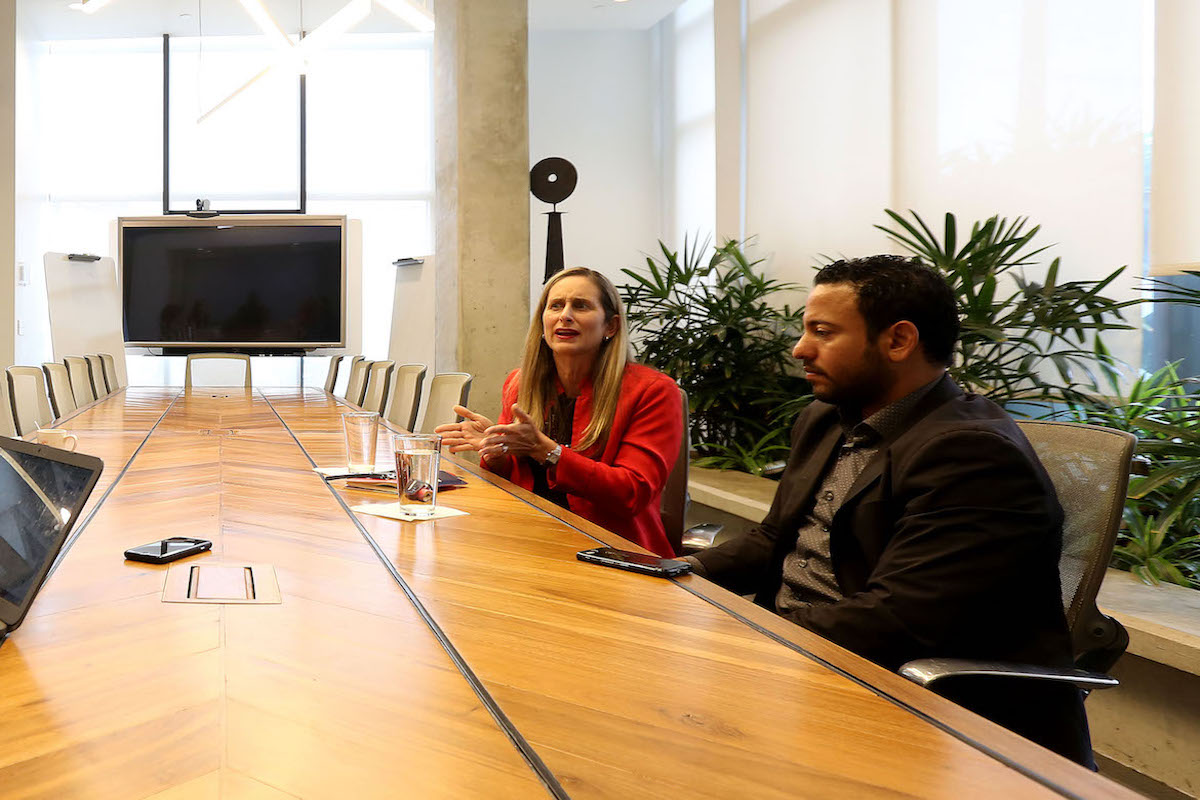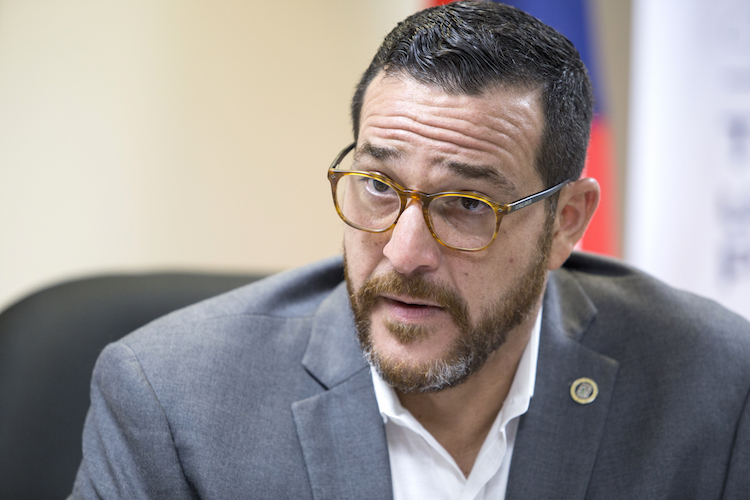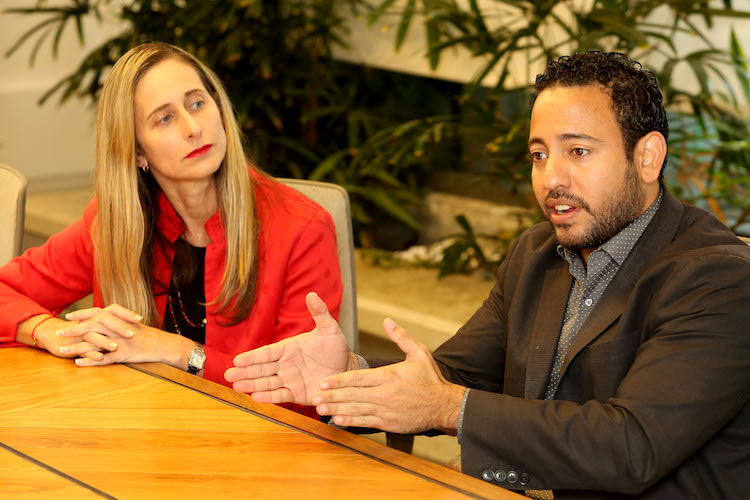

Annie Mayol, president and CEO of the Foundation for Puerto Rico and Arnaldo Cruz, director of research (Photo by Gabriel López Albarrán | Center for Investigative Journalism)
By Jeniffer Wiscovitch
SAN JUAN, PUERTO RICO — Following hurricanes Irma and María, Puerto Rico’s Housing Department awarded its largest federally-funded, recovery-related contract to Foundation for Puerto Rico (FPR) without a proposal that demonstrated the nonprofit organization’s interest or expertise in managing a community planning program.
The local government agency did not disclose the criteria used for the selection of FPR, nor did it take into account citizen participation on this matter. There was no competitive bidding process to administer the $37.5 million in federal funds awarded to FPR under the Community Development Block Grant–Disaster Recovery Program (CDBG-DR) to develop the Whole Community Resiliency Planning Program, confirmed Annie Mayol, president and CEO of Foundation for Puerto Rico.
More than $6 million would cover operational expenses, personnel hiring, consulting, the creation of a webpage and technological tools for managing information and statistics, the contract shows. Housing recently submitted and amendment to the FPR contract to increase its amount to $55 million. FPR’s net assets for 2017 amounted to roughly $8.8 million, according to the organization’s annual report filed with the local State Department.
The Planning Program seeks to create resiliency plans for communities to better prepare these in case of future natural disasters. As done by 30 other nongovernmental organizations, Foundation for Puerto Rico submitted a written testimony when the local Housing Department began to work on the action plan for this program. A few months later, Housing reached out to FPR to bring it on board the program, Mayol said during an interview with the Center for Investigative Journalism (CPI).
Foundation for Puerto Rico was founded in 2011 by Jon Borschow, a political donor of Puerto Rico’s main parties, the New Progressive Party and the Popular Democratic Party. In 2017, Gov. Ricardo Rosselló tapped Borschow to chair Discover Puerto Rico, the island’s newly created destination marketing organization (DMO). The latter stands to receive $25 million in CDBG-DR funds.
According to its website, FPR promotes economic and social development opportunities in Puerto Rico. It focuses on the “visitors’ economy” and transforming the island into a global destination. The organization, however, does not specialize in community planning issues.
“When we were approached [by Housing], we made sure it was a collaborative process, where there would be other organizations with us in the program,” Mayol said. She stressed that Foundation for Puerto Rico has experience in finance, but acknowledged that the organization will need to retain outside technical and specialized personnel, such as planners, to help in the project.
For his part, Housing Secretary Fernando Gil Enseñat said that the government chose FPR because it “always proposed solutions, more than other foundations that were not looking at this globally” during the public hearing process to come up with an action plan for the program. “We also saw [FPR’s] trajectory, that it quickly executed programs [after María],” he added without providing further details.
The government official highlighted the work done by Foundation for Puerto Rico in implementing a program after María, yet could not recall its name nor the number of people benefited. Gil Enseñat only said that FPR offered “cash” to people for economic development projects. He further justified the FPR contract by stating that the organization financially sponsors other nonprofits, providing them with assistance in the procurement and management of federal funds. CPI confirmed that Foundation for Puerto Rico is the fiscal sponsor of Invest Puerto Rico, a government-created, private sector-led organization tasked with the promotion of the island as an investment and business destination.
“Not only because of the work it had done, but also [FPR’s] ability to partner with —and also redistribute internally, within its compliance framework of compliance, which is the thing we like the most— other foundations that can help us address and integrate [other] areas. This is a very complex process, community integration…,” the local Housing chief added.
Gil Enseñat further said there were organizations that “have only wanted to let us know how it is supposed to be, how they understand that the program must be run, without knowing about federal funds nor what these funds require.”
He stated that these organizations showed interest in participating of the proposed program, “but not based on conversations we have had with them, nor what we require, but rather on what they want to implement.” For the government official, this situation “raises a flag” over the possibility of noncompliance with program requirements, which could bring serious consequences such as restitution of federal funds.
The local Housing Department will provide technical assistance and oversee FPR’s work along the process, according to Gil Enseñat.


Fernando Gil Enseñat, Housing Secretary (Photo by Cristina Martínez | Center for Investigative Journalism)
FPR Suddenly Shows Up in Action Plan
Although there was no request for proposal issued and Foundation for Puerto Rico did not submitted a proposal, the commonwealth government awarded the contract to the organization on January 15 of this year.
Through its president, Annie Mayol, FPR has advocated for the promotion of tourism with CDBG-DR funds since its first written testimony sent to the Housing Department. The organization presented as an alternative various of its programs and initiatives, such as the “Visitor’s Economy” and the Bottom Up Destination Recovery Initiative, and then asked that they be included in the Planning Program’s action plan. In an email sent to the Housing Department, Mayol further recommended the inclusion of workforce training activities related to tourism into the plan.
In her comments to the amended action plan, Graciela Eleta, a board member at both Foundation for Puerto Rico and Discover Puerto Rico, argued in favor of allocating “a considerable amount of money” to promote the island as a destination for visitors and conventions. Although Eleta made reference to the DMO and its initiatives, she identified herself as a “representative” of FPR.
In a report to Congress issued in September 2018, the U.S. Office of Inspector General (OIG) disagreed with the idea of having Housing and Urban Development Department (HUD) grant a waiver to Puerto Rico for the use of up to $15 million in CDBG-DR funds to promote tourism and attract new businesses. The OIG stated that “funding would be better used on activities that have a direct impact on the affected communities.” HUD, nevertheless, issued the waiver on Feb. 19 without the OIG changing its adverse opinion. The federal agency approved an additional $10 million for tourism and business promoting activities, for a total of $25 million in CDBG-DR funds, according to a press release from the Puerto Rico governor’s office.
The first two drafts of the action plan —dated May 10 and June 14, 2018, and made available on the local Housing Department’s website so that citizens could make their comments— did not list Foundation for Puerto Rico as administrator of the Planning Program. It was not until the action plan approved by HUD on July 29 that FPR showed up as program administrator, along with the local Housing Department. As a result, citizens and other stakeholders could not comment during that stage of the process on the selection of Foundation for Puerto Rico and its proposed tasks under the Planning Program. According to the public record, no person or entity submitted comments to the action plan in favor of the selection of FPR, except for the organization’s representatives. Instead, the decision to tap Foundation for Puerto Rico was rather questioned.
Mayol could not specify why her organization did not appear in the initial versions of the action plan. She said that regularly, these plans undergo changes during the process.
“All these things change dynamically. Within that process of deliveries and drafts, these exchanges take place, these conversations,” Housing Secretary Gil Enseñat said when asked about why FPR was left out of the plan’s first two drafts.
“In the end, what matters is at the time it is approved. It [FPR] does appear there,” added the government official, who believes that people “had enough opportunity to approve or comment” during public hearings and through the website. “The fact that people can comment or not… They can still comment now, it has never been limited… Everyone can comment whatever they want,” he said, although the official public comment period has ended.
As soon as Foundation for Puerto Rico showed up late in the amended plan, citizens began to question the government’s criteria taken into consideration for its selection, emphasizing the organization’s lack of expertise on community planning issues.
For instance, Ariadna Godreau Aubert, executive director of the nonprofit Ayuda Legal Puerto Rico, mentioned in an October 21, 2018 commentary to the plan that the document fails to specify whether FPR has specialized knowledge in “planning, community work or whether it has had previous experiences that validate it to become a member of this program.”
“We are not satisfied with what the [action] plan established, namely that the criteria to select these communities will be announced in the first quarter of 2019. The centrality of this program requires transparency and specificity from the beginning, so we demand that the eligibility criteria be published in the Action Plan,” Godreau Aubert stated.
FPR President Mayol, for her part, assured that the criteria to select the communities that will receive funds under the program have yet to be defined because they still are in the planning process.
Ivis García Zambrana, an associate professor at the University of Utah, also questioned the role of FPR and the experience of the organization to meet the program’s objectives: to make communities more resilient. She questioned the selection of Foundation for Puerto Rico given the availability of other organizations that have experience in the development of this type of strategic plans. The local Housing Department responded to this question on its website, stating that “Foundation for Puerto Rico is not responsible for developing strategic plans. These plans will be developed by the communities.”
García Zambrana told CPI that the group of academic and practitioner planners she chairs, Planners for Puerto Rico, is concerned about the communities’ process to obtain the funds and how much money will each one receive. The organization does not know either how the Housing Department will evaluate FPR’s work.
Mayol defended the participation of FPR in the program. She noted that since 2015, Foundation for Puerto Rico works on projects in collaboration with other organizations. Mayol explained that it acts as an operational development entity, helping other organizations, specifically in accessing funds through its 501 (c)(3) corporate structure. She further explained that after Hurricane María, FPR helped certain organizations receive $10 million in funds.
“As an organization, we have and have had an organizational structure that allows for to management of projects and large-scale funds, always in collaboration with other organizations. Our vision is not to do everything ourselves, but to have the structure to be able to manage the processes, and in that we have had a lot of experience through El Colaboratorio,” said Mayol, in reference to a co-working space FPR has in Santurce.


Mayol and Cruz explained their perspective on the award of the contract. (Photo by Gabriel López Albarrán | Center for Investigative Journalism)
Arnaldo Cruz, research and analysis director at Foundation for Puerto Rico, said that since before María, “the foundation distinguished itself by its collaborative work and being the leading voice on economic development issues,” through its “Visitor’s Economy” program. He mentioned another research initiative that identified projects and strategies for advancing public policy on economic development issues.
After the hurricane, FPR created a $4.2 million fund through private donations to help in the recovery, Cruz mentioned. With this capital, the entity designed, developed and implemented projects throughout the island. He further said that his organization obtained a $5.5 million grant from the U.S. Economic Development Administration to expand its Bottom of Destination Recovery program in 12 municipalities.
“This is the first time in the history of Puerto Rico that a grant of this magnitude has been given by the Economic Development Administration to a project that is not construction,” argued Cruz, who also chairs the Puerto Rico Statistics Institute.
He said that in order to accept taking over the program, the local Housing agency would need to allow FPR to create its own working group and that “important design decisions had to be made in collaboration and with the support of the third sector.” Last week, Foundation for Puerto Rico announced a multisectoral alliance with organizations that will be working on the program: the Puerto Rico Community Foundation, the Puerto Rico Builders Association, the San Juan Bay Estuary Program and the Puerto Rican Planning Society.
Federico Del Monte Garrido, president of the Puerto Rican Planning Society, said that before the contract was signed, FPR approached his group to collaborate in the recovery efforts of Puerto Rico. However, it was not until recently that FPR reached out to his organization to ask them to be part of the entities that will be offering consultancy on planning, he explained. The specific tasks remain undefined and they have not established whether they will be charging for their services and how much, according to Del Monte Garrido.
He said that his organization told FPR about the need to define the sustainable and resilient model that they want to promote in the communities.
Both Cruz and Mayol stated that the organization is in the process of designing the program.
In contrast, Housing Secretary Gil Enseñat assured that the program’s design is ready. He said that before HUD authorized the $1.5 billion disbursement in federal funds, implementation and collaboration plans for the $37.5 million allocated for the Resiliency Program were ready. “They [FPR] are not in the design, because it is already designed, but rather the implementation of the program and understanding how it is implemented. A phase to receive the input of communities. Foundation [for Puerto Rico] is acting as a project manager, it is not what they specifically want and say,” Gil Enseñat said.
The amended action plan includes a Housing-proposed increase of $17.5 million in funds for the organization. If approved, funding for the Community Resiliency Planning Program would increase from $37.5 million to $55 million. Mayol assured that the additional funds would go to communities in a second phase of the program, which features the preparation of the resiliency plans. Housing chief Gil Enseñat, for his part, said that the amended plan would be approved this week, pumping more money to the programs and adding nine other infrastructure, housing and agricultural initiatives.
The Deal
The local Housing Department and Foundation for Puerto Rico signed a 36-month contract comprising two phases. During the first, FPR would collect information from communities that will be published on a website. In the second phase, the organization would publish a Notice of Availability of Funds. The latter would take place once the announcement is made of that communities can access up to $500,000 to hire experts that would support them in the preparation of their plans, Mayol explained. This would occur by the fourth quarter of 2019, according to the latest action plan.
The proposed amendments to the plan seek to have the funds notice made during the first quarter of this fiscal year. They also eliminate the eligibility of each municipality to receive a refund of up to $20,000 during the first phase of the program. If the changes to the plan are approved, towns could receive a refund, although the amount is not established.
According to Housing Secretary Gil Enseñat, “all” of the program’s money must go to communities. He then said that 88% would “directly” go to communities, while the rest of it would cover administrative expenses. A review of the contract, moreover, shows that $30.6 million will go to communities for the development of their resiliency plans, about 82% of the program’s funds. The remaining $6.9 million will be used for the hiring of employees and FPR payroll, payment of technical personnel or consultants, and travel, equipment and operational expenses.
For the creation and design of a webpage and an app, $600,000 was budgeted, according to the contract. Cruz justified the amount of money allocated for the technological tools that will be used to manage information and statistics. “I can tell you that $600,000 for a project like this is very low,” he said.
The organization Ayuda Legal denounced that the FPR-Housing agreement fails to detail the specific responsibilities on community participation that guarantee equal conditions, establishing decision-making mechanisms and eligibility criteria. The organization also warned that the agreement lacks alternatives to advance funds to communities as they can’t participate relying on reimbursements, which is currently the only option. The organization further stated that the contract had to establish minimum eligibility and participation criteria for communities and municipalities.


